Computational Biology Market Research, 2031
The global computational biology market size was valued at $5.5 billion in 2021, and is projected to reach $31.5 billion by 2031, growing at a CAGR of 19.5% from 2022 to 2031. Computational biology is a branch of biology that uses computers and computer science to understand better and simulate biological structures and processes of life. It comprises the use of computational approaches (such as algorithms) to the representation and simulation of biological systems as well as the interpretation of experimental data on a massive scale.
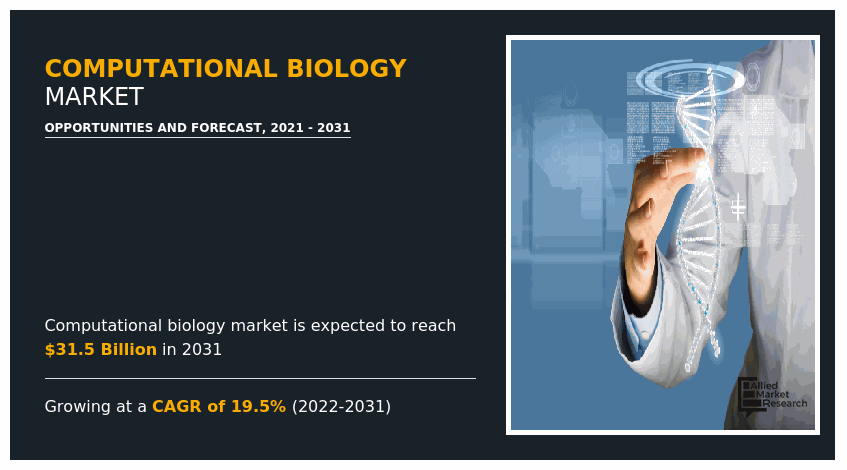
It is an interdisciplinary field that develops and applies computational methods to analyze large collections of biological data, such as genetic sequences, cell populations or protein samples, to make new predictions or discover new biology. The computational methods used include analytical methods, mathematical modelling, and simulation.
The models of biological systems are constructed from experimental measurements. These models describe what biological tasks are carried out by particular nucleic acid or peptide sequences, which gene (or genes) when expressed produce a particular phenotype or behavior, what sequence of changes in gene or protein expression or localization led to a particular disease, and how changes in cell organization influence cell behavior.
Computational biology is helpful in various ways; for instance, along with bioinformatics technology, it helps in accelerating to revel genome and protein structure, variant calling, mutation, and other biological characteristics of SARS-CoV-2. Bioinformatics analysis helps to find the evidence of the origin, host, and evolution of the virus. Furthermore, molecular dynamics simulation, molecular docking, and artificial intelligence (AI) technology of bioinformatics methods can accelerate the development of drugs. Bioinformatics technologies further can develop the effectiveness and safety of the vaccines through reverse vaccinology, immuno-informatics, and structural vaccinology.
The global competitional biology market is expected to witness moderate growth during the forecast period, owing to increase in demand of pharmacovigilance; rise in adoption and development of advanced software for drug discovery; and disease modeling of various diseases such as cardiovascular, cancer, and other infectious diseases. Furthermore, surge in demand for tools of computational biology in various fields such as genomics, epi-genomics, proteomics, and meta-genomics for better understanding of protein structure and interaction provides significant opportunities for existing players and new entrants.
However, complications such as allergic reactions that cannot be detected by computational biology and other post-surgery complications, unfavorable government scenario, high initial cost & maintenance costs of the instruments, lack of standardization, and shortage of skilled workforce are expected to be the significant restraints of the global market.
Computational Biology Market Segmentation:
The computational biology market is segmented into Application, Services and End Use and region. By application, the market is segregated into cellular & biological simulation, drug discovery & disease modeling, pre-clinical drug development, clinical trials, and human body simulation software.
The cellular & biological simulation is sub-segmented into computer, genomics, computational proteomics, pharmacogenomics, and others. The drug discovery & disease modeling segregated into target identification, target validation, lead discovery, and lead optimization. The pre-clinical drug development segmented into pharmacokinetics and pharmacodynamics. The clinical trials are subcategorized into phase I, phase II, and phase III.
On the basis of services, the segment is divided into in-house services and contract. On the basis of end use the segment is divided into academics & research and commercials. Region wise, it is analyzed across North America, Europe, Asia-Pacific, and LAMEA.
Application Segment Review
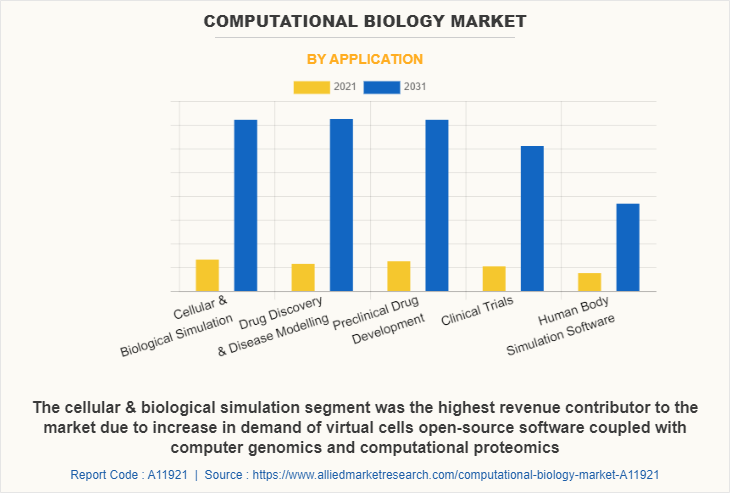
By application segment, the computational biology market size is divided into cellular and biological simulation, drug discovery & disease modeling, pre-clinical drug development, clinical trials and human body simulation software. The cellular & biological simulation segment was the highest revenue contributor to the market. Owing to increase in demand of virtual cells open-source software, computer genomics & computational proteomics also many private and commercial cloud platforms work in collaboration with governmental and public entities to provide cellular & biological simulation service are expected to drive the market growth.
The drug discovery & disease modeling segment is estimated to be the fastest growing segment during the computational biology market forecast. Owing to increase in number of drug development and rise in awareness regarding target selection by using various methods such as assay and readers, automation and high content screening.
Services Segment Review
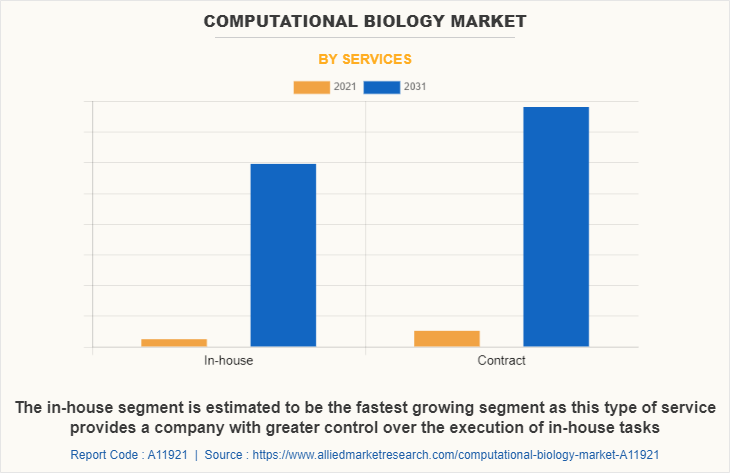
By services, the contract segment was the highest revenue contributor to the market. This is owing to the fact that contract services are cheap when compared to the in-house services provided worldwide. Contract Research Organization (CRO) pro service providers work with clients to develop a customized plan as per the requirements therefore, act as a driver to boost the growth of the market.
The in-house segment is estimated to be the fastest growing segment. In-house service provides a company with greater control over the execution of in-house tasks, since it is the direct employer-based services also because of the advantages such as cost and time saving.
End use Segment Review
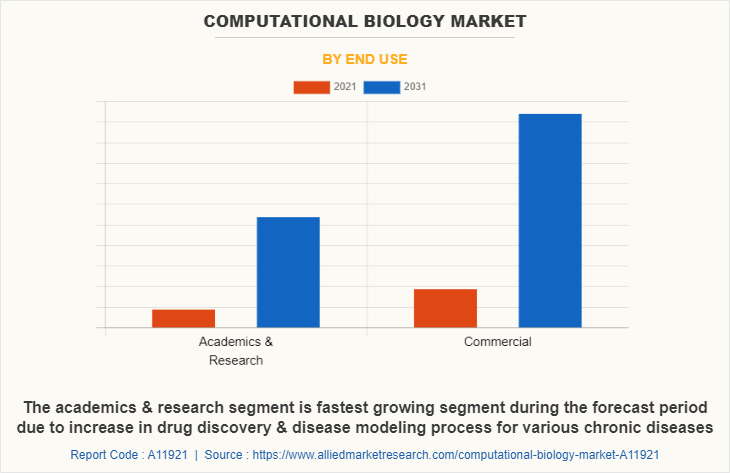
By end use, the commercial segment was the highest revenue contributor to the market. Due to increasing investment in Research and Development (R&D) in genetic engineering and new drug discovery by public as well as private companies, which contribute in the growing demand for computational biology significantly.
The academics & research segment is fastest growing segment during the forecast period. Owing to increase in drug discovery & disease modeling process for various chronic diseases such as cancer, diabetes, cardiovascular diseases, and respiratory disorders that create demand for this segment also increase in demand for predictive models, usage in population-based sequencing projects such as human genome project, and government funding is contributing in the growth of computational biology market analysis.
Region Segment Review
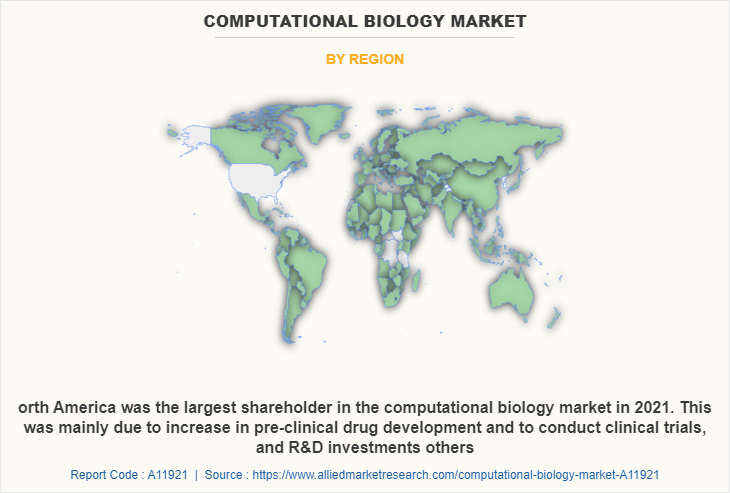
Region wise, the computational biology market trend is analyzed across North America, Europe, Asia-Pacific, and LAMEA. North America was the largest shareholder in the computational biology market in 2021. Increase in demand of pharmacovigilance for the pre-clinical drug development and to conduct clinical trials, R&D investments, and supportive government initiatives are the major factors that drive growth of the computational biology market share.
LAMEA is estimated to grow fastest during the forecast period. Rise in number of product approval, increase in number of clinical trials procedures, surge in demand for bioinformatics tools & services emphasis of prominent players in enhancing their presence and high demand for advanced computational biology software in the region.
Key players operating in the global computational biology market growth include Altaris Capital Partner, Compugen Ltd., Certara, Genedata AG, Dassault Systems, DNAnexus, Nimbus Discovery, Instem, Rosa & co. Ltd., and Simulation Plus.
KEY BENEFITS FOR STAKEHOLDERS
- The study provides an in-depth analysis of the computational biology market, and the current computational biology market trends and future estimations to elucidate imminent investment pockets.
- It presents a quantitative analysis of the market from 2022 to 2031 to enable stakeholders to capitalize on the prevailing market computational biology market opportunity.
- Extensive analysis of the market based on procedures and services assists to understand the trends in the computational biology industry.
- Key players and their strategies are thoroughly analyzed to understand the competitive outlook of the market.
Computational Biology Market Report Highlights
| Aspects | Details |
| By Application |
|
| By Services |
|
| By End Use |
|
| By Region |
|
| Key Market Players | Compugen Ltd., Genedata AG, Entelos, Rhenovia Pharma SAS, Certara, Nimbus Discovery LLC, Insilico Biotechnology AG, Simulation Plus Inc., Rhenovia Pharma SAS & Leadscope Inc., Accelrys, Chemical Computing Group Inc. |
Analyst Review
In accordance to several interviews conducted, computational biology is expected to gain high traction in future, owing to rise in number of clinical studies in the field of pharmacogenomics, surge in number of key players to launch various computational biology products, increase in number of clinical trials, and surge in R&D expenditure.
According to the insights of CXOs, the global computational biology market is progressing well, as the demand for genetics, evolution, cell biology, biochemistry, and other areas of biology grows. The need for computational biology is being boosted by rapid development of industries such as clinical research organizations and pharmaceuticals. For instance, the Human Genome Project is a classic example where the whole human genome was sequenced successfully. Computational biology further finds application in neurology, in which it is used to map complex interlinked pathways to visualize 3D simulation models of the brain. The medical advantage of computational biology is anticipated to boost the computational biology market during the forecast period. Moreover, computational pharmacology uses tools of computational biology to visualize and simulate advanced drug–drug interactions in the drug designing process.
Few trends include Increase in number of pharmacodynamic studies conducted with the use of software to evaluate balance of excretion and pulmonary excretion coupled with systems biology & the application of data-analytics and algorithms
The cellular & biological simulation segment was the highest revenue contributor to the market. Owing to increase in demand of virtual cells open-source software, computer genomics & computational proteomics also many private and commercial cloud platforms work in collaboration with governmental and public entities to provide cellular & biological simulation service are expected to drive the market growth.
Region wise, the computational biology market is analyzed across North America, Europe, Asia-Pacific, and LAMEA. North America was the largest shareholder in the computational biology market in 2021. Increase in demand of pharmacovigilance for the pre-clinical drug development and to conduct clinical trials, R&D investments, and supportive government initiatives are the major factors that drive growth of the computational biology market.
Dassault systemes, Certara and Compugen Ltd. hold major share in the computational biology market in 2021.
The global computational biology market was valued at $5,493.2 million in 2021, and is projected to reach $31,477.1 million by 2031, registering a CAGR of 19.5%.
Few major driving factors for computational biology market are technological developments coupled with the rising need for pharmacovigilance
Increase in demand of drug development and disease modeling services and rise in demand of cellular & biological simulation due to increased unmet medical needs and burgeoning demand for personalized medicines act as the key driving forces of the market in Asia-Pacific. Furthermore, increase in demand for computational proteomics & transcriptomics/metabolomics for the development of drugs and vaccines will help the region the grow at a faster growth rate during the analysis period.
Strategic initiatives undertaken by major players such as Genedata AG, Simulation Plus and Certara are product launch, acquisition and collaboration during 2020-2022.
Loading Table Of Content...


